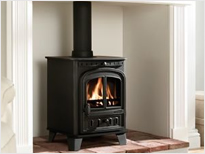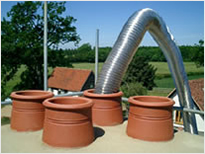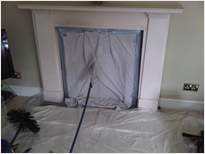
Stove installation
Chimney sweeping and maintenance
 Call now on 01923 711766 / 07790 100526
Call now on 01923 711766 / 07790 100526
 Call now on 01923 711766 / 07790 100526
Call now on 01923 711766 / 07790 100526Chimney sweeping
Chimney sweep in Gerrards Cross, Rickmansworth, Chorleywood and the Chalfonts
Why sweep your chimney?
Having your chimney swept by a chimney sweep is is part of the correct operation and maintenance of your fireplace or stove. It is one of the most important tasks that are associated with operating a live fire of any kind. Tar, soot and deposit build up in a chimney can restrict the area in the chimney, reducing draw, making the fireplace or stove run poorly and in the end make the fireplace or stove smoke.
If you have a soot fall it can not only make a real mess of your room, but more importantly block the flue and make a great deal of smoke. The build up of deposits in your chimney flue could lead to a potentially dangerous chimney fire.
A CLEAN CHIMNEY IS A SAFER AND MORE EFFICIENT CHIMNEY
How often does my chimney need sweeping
Sweeping frequency will depend on a number of factors including: type of fuel, appliance used, type of chimney, duration of use, moisture content of fuel used. Heavy usage will require a more regular sweeping. The typical recommended intervals are:
- Solid fuel - smokeless- annually
- Solid fuel - bitumous- six monthly
- Gas fuel - annually
- Oil fuel - annually
- Wood fuel - quarterly
For the safe and efficient working of a fireplace or multifuel stove, it is essential that it is serviced at least annually.
Birds nests, vermin, heavy soot or tar deposits and fallen brickwork can also lead to dangerous situations and run the risk of a chimney fire.


Armstrong Chimneys will sweep your chimney with no mess and no fuss, all chimneys are swept to BS 6461 using a suitable sized brush and vacuum.
- The fireplace or stove is first sealed up with a specially designed cloth sheet and the vacuum and brush rods are worked through it. As the soot falls down, the vacuum removes it or it is fully contained.
- The chimney is the smoke tested for spillage and to ensure the flue is drawing correctly.
- The chimney is then subjected to a full visual inspection both inside and outside.
- Terminals are checked to ensure that they are suitable for the application.
- A report of the findings is then supplied along with a certificate for your reference.
- The whole process takes around an hour to complete.

It is not commonly known but most building insurance policies require a certificate as proof of an annual service of the appliance that it serves. Policies can be invalidated if this certificate is not produced on request.
Not what you were looking for?
Try one of these pages:

